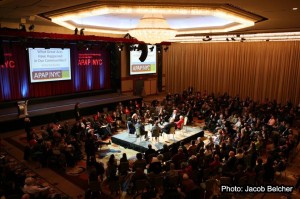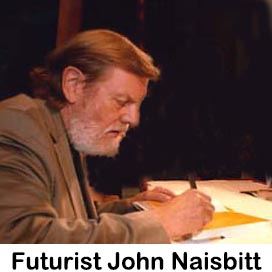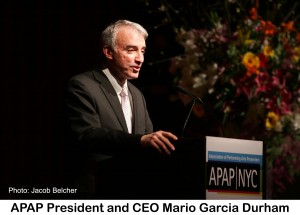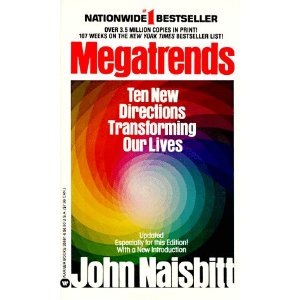The Marlowsphere (#30)
The 2012 Association of Performing Arts Professionals (APAP)/JazzTimes/Jazz Journalists Association (JJA)/Chamber Music America (CMA) conferences* held earlier this year shared a common thread: social media’s impact on today’s working musician. This week’s and next week’s blogs describe this thread and how they exemplify the forecasts of a book published three decades ago.
Thirty years ago in his 1982 book Megatrends: Ten New Directions Transforming Our Lives, author and futurist John Naisbitt postulated that among other directions, one would be “high- tech/hi-touch.” By this he meant that the more high technology we adopt, the more person-to-person, face-to-face interaction would be fostered, even demanded.
The general perception (in part fostered by “the media” and mis-guided, cynical, and conservative media gurus) is that the inexorable growth of high technology—specifically communications (i.e., telecommunications) and information (i.e., the computer) technologies–separates people from one another and puts people in isolation. Fact is, even though we can now communicate with people across the globe in an instant one-to-one or one-to-many mode, high technology also fosters the demand to see and meet people in the flesh. It is an unavoidable human response. It also creates the demand for individuals to adapt to the reality that single abilities in the professional world are not adequate any more; people must be multi-faceted in their skills and abilities, as in the expanding world of social media and DIY: Do It Yourself.
The Evidence (in a few words)
The “high-tech/hi-touch” concept is much in evidence. 9/11 notwithstanding, international travel has grown in the last 30 years—about 5% a year–paralleling the growth in telecommunications and the World Wide Web, and the ever-expanding power of computer technology. More people are going to “live” athletic and entertainment events than ever before and this is an international phenomena. Global trade has grown exponentially.
For the jazz musician and the music industry generally, with some exceptions, “live performance” has become the norm for income, not CD sales. It is at the live performance that musicians, especially jazz musicians, sell more hard copy CDs than anywhere else. Everything else is a digital download on a global basis.
 The APAP/JazzTimes/JJA/CMA Conferences
The APAP/JazzTimes/JJA/CMA Conferences
All of the above was also much in evidence at several conferences that took place in New York City between January 5-15: the 2012 conference of the Association of Performing Arts Presenters (APAP) (primarily at the Hilton Hotel), a series of sessions organized by Lee Mergner’s JazzTimes Magazine, concurrent sessions of the Jazz Journalists Association (JJA) (at the Hilton and the neighboring Sheraton), and the 2012 Chamber Music America (CMA) conference (at the Westin Hotel).
While the APAP conference covered the wide range of entertainment offerings (from classical, to pop, to Broadway, et al), and Chamber Music America focused primarily on classical and jazz chamber music, what was apparent across all genres was the in-your-face presence of technology’s impact on the performing arts professions, particularly “social media.”
Social Media/Social Contact/DIY Skills
The call of social media was everywhere: Facebook, Twitter, YouTube, Vimeo, web sites, blogs, and crowd-funding (as in Kichstarter, RocketHub, indiegogo). What was also readily apparent was the demand on all aspects of the performing arts professions (including the journalists) to expand skills beyond the performing (and writing) arts. The days of, for example, a jazz musician focusing purely on the art and craft of playing an instrument, or composing/arranging, are gone forever. Today, the call is not only for professional performance excellence, one’s portfolio must also include some technology skills, and marketing and sales acumen.
Beyond this, though, the abovementioned conferences also pointed to the need for an awareness of the larger world beyond the performance stage, as in: what are the demographics of my audience? What motivates them to come to a performance, to purchase a CD? And what do I need to do to become a “profitable artist,” as opposed to a performer who just barely makes the rent? More on the “profitable artist” in next week’s blog.
The conferences also showed clearly that while technology (including social media) can help expand a performer’s circle of “friends,” and expand performance possibilities, the other side of the coin—as Naisbitt demonstrated 30 years ago—is that there is still no substitute for a face-to-face meeting to move a professional relationship forward. To reiterate Naisbitt’s insight: the more high technology we have, the more there is a need for direct, face-to-face communication.
In 2012 this is exactly where we are: as more technology has invaded our personal and professional lives, the more we feel the need for face-to-face, one-on-one communication. If this were not so, every educational institution, in the United States at least, would have gone the route of “distance learning”–teleconferencing and online education–by now. What has actually happened is that “distance learning” has provided educational opportunities for those who would not otherwise have access, or provided an educational context for those whose schedules fit the “technological” education conduit. For example, can you teach playing the trumpet over a phone, a cable line, or via satellite? The “live” classroom is still the best teaching environment.
Naisbitt’s Forecasts
 Naisbitt’s now apparent accurate vision of the future included the following forecasts:
Naisbitt’s now apparent accurate vision of the future included the following forecasts:
- Becoming an information society after having been an industrial one
- From technology being forced into use, to technology being pulled into use where it is appealing to people
- From a predominantly national economy to one in the global marketplace
- From short-term to long-term perspectives
- From centralization to decentralization
- From getting help through institutions like government to self-help
- From seeing things as “either/or” to having more choices
- From hierarchies to networking
All the above ring true for those in the performing arts. Newly appointed APAP President and CEO Mario Garcia Durham referred to a “We Are  They” paradigm, one in which members of the performing arts community take responsibility for “The Road Ahead,” the theme of the 2012 APAP conference. President Durham also referenced the need to pay attention to changing demographics and the need to take care of one another in a changing world. Is this not also an echo of the Do It Yourself (DYI) concept postulated by Naisbitt when he proffers: “From getting help through institutions like government to self-help.”
They” paradigm, one in which members of the performing arts community take responsibility for “The Road Ahead,” the theme of the 2012 APAP conference. President Durham also referenced the need to pay attention to changing demographics and the need to take care of one another in a changing world. Is this not also an echo of the Do It Yourself (DYI) concept postulated by Naisbitt when he proffers: “From getting help through institutions like government to self-help.”
Demographics & Economics
The need for those in the performing arts to pay more attention to audience demographics was a theme expressed in several places. APAP opening plenary speaker Carol Coletta, president of ArtPlace, spoke at length about shifting audience demographics. She also noted the difference between those with college degrees and those with high school diplomas with respect to annual earnings as it impinged on performance attendance and cultural connectedness. Ms. Coletta pointed out that those in the former category have a good chance of earning in excess of $67K a year, while those in the latter category will earn half that, in the range of $25K a year. She went on at length to describe the need for performing arts presenters to pay attention to demographics in a shifting world, emphasizing the driving motivation that puts people in the seats: an emotional connection to the event. Audiences, she said, and I paraphrase, want to feel connected to the artists and the performance. Presenters and performers need to give audience that emotional reason.
 A few days later, Jean Cook, Director of Programs for the Future of Music Coalition (Education, Research and Advocacy for Musicians), in a highly organized presentation as part of the JazzConnect sessions, spoke with precision about the economic status of musicians generally, and jazz musicians in particular. Of note, she provided evidence that jazz musicians earned on average $25K a year from performing and performance related activities, about the same as someone with a high school diploma, despite the fact that to perform at any meaningful professional level requires, these days, much more education than a high school diploma. There was a moment of silence in the room when this was brought to light.
A few days later, Jean Cook, Director of Programs for the Future of Music Coalition (Education, Research and Advocacy for Musicians), in a highly organized presentation as part of the JazzConnect sessions, spoke with precision about the economic status of musicians generally, and jazz musicians in particular. Of note, she provided evidence that jazz musicians earned on average $25K a year from performing and performance related activities, about the same as someone with a high school diploma, despite the fact that to perform at any meaningful professional level requires, these days, much more education than a high school diploma. There was a moment of silence in the room when this was brought to light.
More on these conferences and the “Hi-Tech/Hi-Touch” connection and the profitable artist in next week’s blog.
*2013 Conferences:
Jazz Connect (JazzTimes) January 9-10
Association of Performing Arts Professionals (APAP) January 10-11
Jazz Journalists Association (JJA) January 11-15
Chamber Music America (CMA) January 17-20
Please write to me at meiienterprises@aol.com if you have any comments on this or any other of my blogs.
Eugene Marlow, Ph.D.
October 1, 2012
© Eugene Marlow 2012


